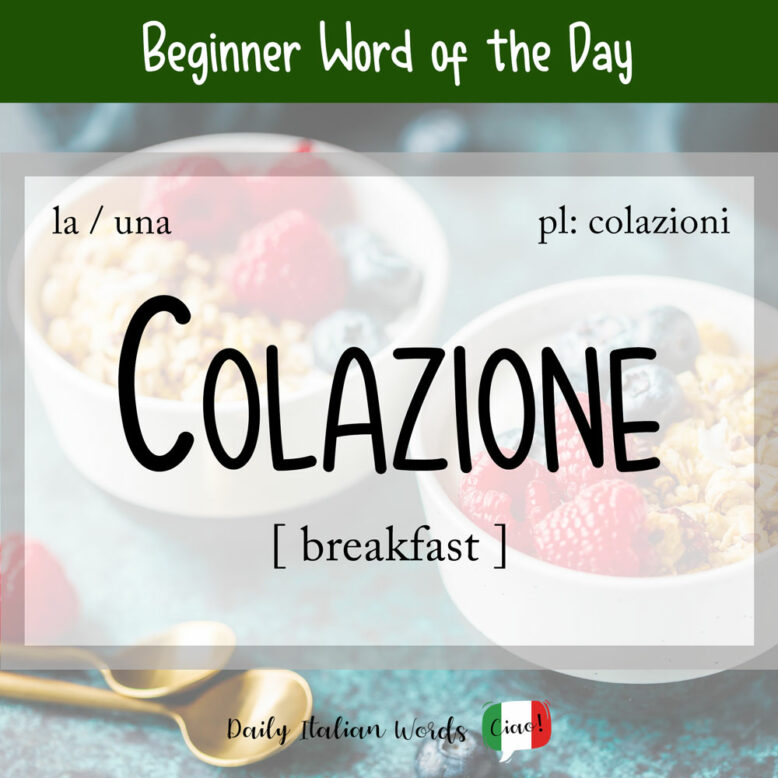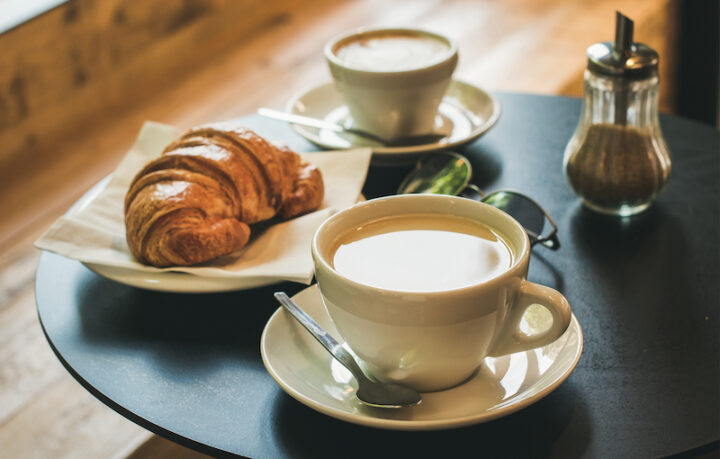The word for breakfast in Italian is colazione (feminine, plural: colazioni).

Traditionally, the first meal eaten just after waking up was referred to as la prima colazione (the first breakfast), whereas the midday meal was called la seconda colazione (the second breakfast). The latter has since been replaced by the word pranzo (lunch) but the term prima colazione still survives today.
Non bisogna saltare la colazione perché è il pasto più importante della giornata.
We shouldn’t skip breakfast because it is the most important meal of the day.
The Italian term comes from the ancient French word collatiòn, which in turn derives from the low Latin collatiònem meaning to contribute / bring together. It is said that term was originally used to describe the meal that the Christian monks of the 4th century took after their evening meeting. (Source: Treccani)

A traditional Italian breakfast for an adult normally consists of hot milk with coffee (caffè latte), a simple coffee (caffè) or tea (tè) along with bread (pane), butter (burro), jam (marmellata), rusk (fette biscottate), milk buns (panini al latte) and biscuits (biscotti).
Children often drink warm milk (latte caldo) that may contain either barley coffee (caffè d’orzo) or chocolate (cioccolata). Yogurt, fruit juices (succhi di frutta), honey (miele) and cereal (cereali) are also popular choices these days.
Those who go to cafés (bar) for breakfast will tend to choose a cappuccino or espresso accompanied by a croissant (cornetto) or other type of pastry (pasticcino).
Hai già mangiato? No? Allora andiamo a fare colazione al bar.
Have you eaten already? No? Then let’s go have breakfast at the café.

Some other phrases containing the word colazione describe different types of breakfast:
- colazione all’inglese = English breakfast
- colazione alla forchetta / in forchetta = breakfast with solid food, warm or cold, that requires the use of a knife and fork
- colazione al sacco = packed breakfast to take on a walk or class trip, you can also say pranzo (lunch) or merenda al sacco (snack)
- colazione di lavoro = a quick lunch with colleagues where you discuss business while eating
Following breakfast is lunch (pranzo), which is regarded as the most important meal of the day. Most businesses allow their employees a lunch break (pausa pranzo) which lasts from 1 p.m. to 3 p.m. After school, many children and adults enjoy a mid-afternoon snack called merenda. The day ends with supper (cena) during which a primo (first course) and secondo (second course) are usually served. In contrast to Anglosaxon countries where supper is consumed quite early in the evening, Italians tend to eat between 7 p.m. and 9 p.m.
Heather Broster is a graduate with honours in linguistics from the University of Western Ontario. She is an aspiring polyglot, proficient in English and Italian, as well as Japanese, Welsh, and French to varying degrees of fluency. Originally from Toronto, Heather has resided in various countries, notably Italy for a period of six years. Her primary focus lies in the fields of language acquisition, education, and bilingual instruction.


